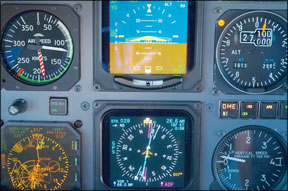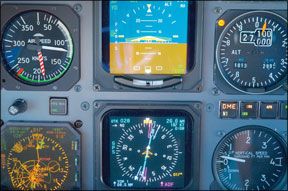I fly a lot of IFR year round and a fair amount of actual IMC during the winter, but not much in the summer. Like everyone else, Ive heard the wakeup call from Center in that unmistakable tone that says, “Were not amused that you think flex-altitudes are in use today…please get back to 5000 feet. Now.” 288 That sort of thing may be a minor mistake, but if you add up enough minor mistakes, youve got a trend and that could lead to something ugly. The 24-month flight review and instrument proficiency checks are supposed to correct the inevitable decline in skill for those of us who dont fly much, but there may be a better way. A Little Discipline Practicing bad habits is unproductive in any activity, so if you can identify your subtle faults and correct them on the spot, arent you better off? My suggestion is to discipline yourself to set aside some mental bandwidth on every flight for an honest assessment of your basic IFR skills. Dont try to do everything on every flight and dont wait for your next IPC, either. Do a searing self review on every flight, for 10 or 15 minutes. So what are you looking for, exactly? That will vary by pilot and experience but Ive developed a flight-segment based self review. I grade the climb, cruise, track, descent and approach or maybe even how well I stay on the centerline of the taxiway. Try something different on each flight and you may find you really dont need a CFII to tune up your skills. Keep a notepad in your flight bag along with your logbook with some pages marked for each major flight segment. Make notes of which ones you did well and which need work. If you watch golf tournaments or football on TV, youll see the pros making notes and studying pictures of plays so they can review their shortcomings and improve their performance next time. Same idea here. Its easier to do that when the flight is fresh in your mind, so dont save it for later. Most of us drift away from precise flying in a slow, graceful degradation. Drifting back to a higher standard will take a little time, too, but having those notes and comments will help you find your groove again. Here are some ideas Ive tried. Fessing up here, Im not mentioning the qualitative values involved in order to protect the innocent. Climb Phase What does a dot of pitch really mean in a typical climb? Can you even hold a dot? Fresh from the instrument checkride, you could probably change the pitch five degrees and simultaneously adjust the throttle to hold the climb rate. Can you still do that? I fly a twin that doesnt use much more gas at 2000 feet than it does at 8000 feet, so I like to fly a faster cruise climb whenever I can. It gives me a sense of going somewhere while I climb. VY and VX are good to know, but the cruise climb option lets me practice rate-of-climb changes with a constant airspeed and work on precise one- or two-dot attitude changes for a few minutes running instead of for one minute during takeoff. I can keep the climb at least 500 feet per minute to keep ATC happy, and then see what a dot change does or if I can maintain that for two or three or five minutes without deviation. Cruise Phase Not much to do here, right? Maybe not if youre letting the autopilot fly, but hand flying cruise precisely for a long period is challenging. Can you hold the altitude to 50 feet? How about 10 feet? How about heading control? Maybe the needles are centered or youre on the magenta line, but are you wandering across 20 degrees of heading change to bracket the course? Write these things down in your notebook and compare them to your next flight to see if you need work. Cruise flight is a good opportunity to fine-tune your scan to detect and correct microtrends almost automatically. Dont give up all of cruise to the autopilot. Its only boring if you let it be that way. Holding Go ahead. Ask for it. One turn every three months instead of every six will keep you sharper on procedure turns and more comfortable calculating outbound leg changes, whether you actually get a real-world hold or not. I try to do this as a courtesy to controllers when I hear them asking for heading changes to adjust sequencing. Sometimes they like the idea of a few spins, sometimes not. Although it varies by ATC facility and airspace, controllers seem to favor vectors and speed control over holding. That may not be a bad idea, but one or two turns in a hold will burn about the same gas and give you some practice. Of course, if you didnt do well in the cruise drills, you may be given another option compliments of an irate controller. Descent Conceptually, its a climb in reverse. But the twist is you may be asked to meet a crossing restriction. How do you do that? Math in your head? Vertical nav in your panel-mount box or portable GPS? Either way, run a problem and see how you do with it. (Just because ATC hasnt given you a crossing restriction doesnt mean you cant make one up.) Reviewing whatever method you use for setting descent rate and speed is a good exercise. Can you still descend at 700 fpm without overspeeding? What does half a dot of nose-down pitch yield in descent rate and at what power settings? Set up your little quiz and make notes on how you do. Remember that instructor who made you fly an occasional VFR pattern by sound instead of airspeed or rpm just to give you a better feel? The same holds for fine tuning adjustments in the descent or on final. Knowing that so much change in throttle gives you one dot of pitch or 100 feet of descent change at constant pitch lets you focus on a smoother approach. And speaking of that…. Approach On a clear day with an observer, try that arc approach you always worried about, or that NDB (if you still have one) instead of the straight-in VOR or an ILS. And actually, how good is your ILS? Can you center the needles and hold ATP standards? It really doesnt take much practice to get there. If you fly the same route or are routinely vectored to the localizer with a 20-degree intercept just outside the final approach fix and you then fly a standard three-degree slope at routine power and pitch, youre liable to get complacent. With gas at or over $5 a gallon, its less compelling to fly to some nearby field just for practice, but when you use the airplane for travel, seek out the unusual. Rather than accepting vectors, ask to get on the arc thats on the side of the airport youre approaching from anyway. Or ask for the full approach, so you can use your timing and holding skills and also keep current on setting up a navigator for such procedures. Summary Instrument flying is supposed to be about precision and smooth execution. The day after your checkride, it probably was. But without regular practice and training, the skill is sharply perishable-more for some than for others. You can arrest the slide by exercising a little iron-handed discipline. Dont let the altitude waiver; dont accept two dots low on the glideslope when you know you can center it on the donut. With gas as expensive as it is these days, you simply wont have as many opportunities as you used to have to practice, so make every opportunity count. Any professional does that and, whether youre paid to fly or not, professionalism derives from discipline and an organized method of constant self-improvement. Youll be not just a better pilot for it, but safer, too. Bill Straw is a 4000-hour commercial instrument-rated pilot who flies a 1971 Turbo Skymaster




